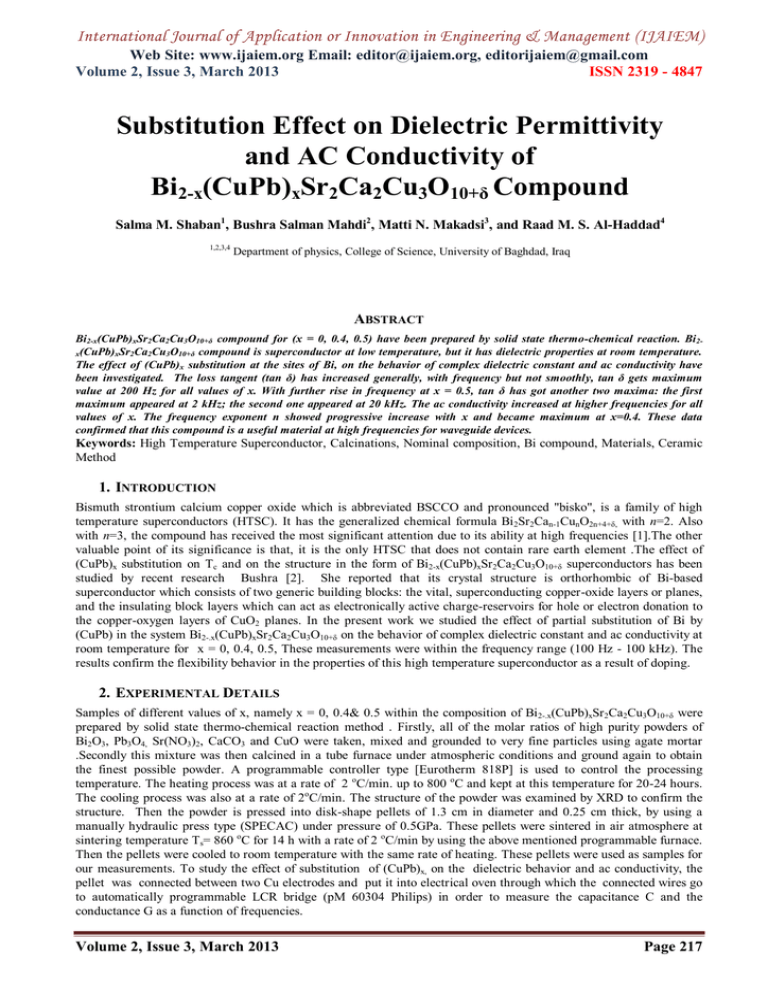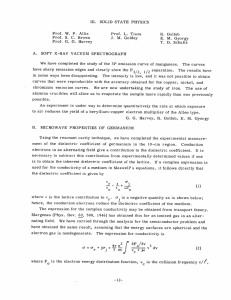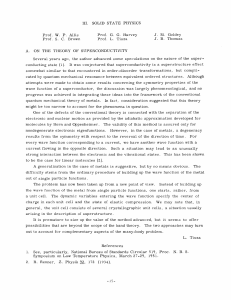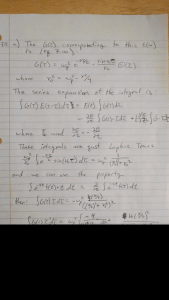International Journal of Application or Innovation in Engineering & Management... Web Site: www.ijaiem.org Email: , Volume 2, Issue 3, March 2013
advertisement

International Journal of Application or Innovation in Engineering & Management (IJAIEM) Web Site: www.ijaiem.org Email: editor@ijaiem.org, editorijaiem@gmail.com Volume 2, Issue 3, March 2013 ISSN 2319 - 4847 Substitution Effect on Dielectric Permittivity and AC Conductivity of Bi2-x(CuPb)xSr2Ca2Cu3O10+δ Compound Salma M. Shaban1, Bushra Salman Mahdi2, Matti N. Makadsi3, and Raad M. S. Al-Haddad4 1,2,3,4 Department of physics, College of Science, University of Baghdad, Iraq ABSTRACT Bi2-x(CuPb)xSr2Ca2Cu3O10+δ compound for (x = 0, 0.4, 0.5) have been prepared by solid state thermo-chemical reaction. Bi2x(CuPb)xSr2Ca2Cu3O10+δ compound is superconductor at low temperature, but it has dielectric properties at room temperature. The effect of (CuPb)x substitution at the sites of Bi, on the behavior of complex dielectric constant and ac conductivity have been investigated. The loss tangent (tan δ) has increased generally, with frequency but not smoothly, tan δ gets maximum value at 200 Hz for all values of x. With further rise in frequency at x = 0.5, tan δ has got another two maxima: the first maximum appeared at 2 kHz; the second one appeared at 20 kHz. The ac conductivity increased at higher frequencies for all values of x. The frequency exponent n showed progressive increase with x and became maximum at x=0.4. These data confirmed that this compound is a useful material at high frequencies for waveguide devices. Keywords: High Temperature Superconductor, Calcinations, Nominal composition, Bi compound, Materials, Ceramic Method 1. INTRODUCTION Bismuth strontium calcium copper oxide which is abbreviated BSCCO and pronounced "bisko", is a family of high temperature superconductors (HTSC). It has the generalized chemical formula Bi2Sr2Can-1CunO2n+4+δ, with n=2. Also with n=3, the compound has received the most significant attention due to its ability at high frequencies [1].The other valuable point of its significance is that, it is the only HTSC that does not contain rare earth element .The effect of (CuPb)x substitution on Tc and on the structure in the form of Bi2-x(CuPb)xSr2Ca2Cu3O10+δ superconductors has been studied by recent research Bushra [2]. She reported that its crystal structure is orthorhombic of Bi-based superconductor which consists of two generic building blocks: the vital, superconducting copper-oxide layers or planes, and the insulating block layers which can act as electronically active charge-reservoirs for hole or electron donation to the copper-oxygen layers of CuO2 planes. In the present work we studied the effect of partial substitution of Bi by (CuPb) in the system Bi2-.x(CuPb)xSr2Ca2Cu3O10+δ on the behavior of complex dielectric constant and ac conductivity at room temperature for x = 0, 0.4, 0.5, These measurements were within the frequency range (100 Hz - 100 kHz). The results confirm the flexibility behavior in the properties of this high temperature superconductor as a result of doping. 2. EXPERIMENTAL DETAILS Samples of different values of x, namely x = 0, 0.4& 0.5 within the composition of Bi2-.x(CuPb)xSr2Ca2Cu3O10+δ were prepared by solid state thermo-chemical reaction method . Firstly, all of the molar ratios of high purity powders of Bi2O3, Pb3O4, Sr(NO3)2, CaCO3 and CuO were taken, mixed and grounded to very fine particles using agate mortar .Secondly this mixture was then calcined in a tube furnace under atmospheric conditions and ground again to obtain the finest possible powder. A programmable controller type [Eurotherm 818P] is used to control the processing temperature. The heating process was at a rate of 2 oC/min. up to 800 oC and kept at this temperature for 20-24 hours. The cooling process was also at a rate of 2oC/min. The structure of the powder was examined by XRD to confirm the structure. Then the powder is pressed into disk-shape pellets of 1.3 cm in diameter and 0.25 cm thick, by using a manually hydraulic press type (SPECAC) under pressure of 0.5GPa. These pellets were sintered in air atmosphere at sintering temperature Ts= 860 oC for 14 h with a rate of 2 oC/min by using the above mentioned programmable furnace. Then the pellets were cooled to room temperature with the same rate of heating. These pellets were used as samples for our measurements. To study the effect of substitution of (CuPb)x, on the dielectric behavior and ac conductivity, the pellet was connected between two Cu electrodes and put it into electrical oven through which the connected wires go to automatically programmable LCR bridge (pM 60304 Philips) in order to measure the capacitance C and the conductance G as a function of frequencies. Volume 2, Issue 3, March 2013 Page 217 International Journal of Application or Innovation in Engineering & Management (IJAIEM) Web Site: www.ijaiem.org Email: editor@ijaiem.org, editorijaiem@gmail.com Volume 2, Issue 3, March 2013 ISSN 2319 - 4847 3. RESULTS AND DISCUSSIONS 3.1 Dielectric Behavior with Frequency Fig. 1(a, b, and c) shows the frequency variation of dielectric constant (ε1), dielectric loss (ε2), and loss tangent tan(δ) measured at room temperature for different substitution values of x in the HTSC Bi2-.x(CuPb)xSr2Ca2Cu3O10+δ . From figure (1a), it has been observed a sharp decrease in ε1 in the early steps of measurement for the three samples. However the starting values of ε1 for these samples are different. The samples with x= (0 and 0.4) behaved almost similarly with the variation of frequency, but the sample of x=0.5 showed much higher initial value of ε1 than those with x= 0 (undoped) and x= 0.4. After the sharp decrease in the first early steps of frequency variation, ε1 kept nearly constant within the measured range of frequency for the three samples. However, the nearly constant values of ε1 for the samples with x= (0 and 0.5), were a bit lower than that for x=0.4. The observed initial sharp in ε1 decreases with frequency in the early stages of measurement. According to Kim et al [3], the compound exhibits different types of polarizations under ac field (i.e. interfacial, dipolar, atomic, ionic, and electronic). Another interpretation is given by Emery and Kivelson [4], they attributed such behavior to strong phase fluctuation. Such phenomena may affect the coherency of Cooper pairs. However afterwards the structure relaxed to a stable state, and became, nearly, independent on frequency. Hence it can be say that this behavior is a result of transition to an order of directional orientation of permanent dipoles along a particular direction. Fig.1. Frequency variation of (a) Dielectric Constant ε1, (b) Dielectric Loss ε2, and (c) Loss tangent (tan δ), for Bi2.x(CuPb)xSr 2Ca2Cu3O10+δ at different values of x From figure 1b, it is observed that the variation of dielectric loss ε2 was not similar for the three samples, for x=0, the variation at the start was very small and then kept constant at zero value. This frequency-independent value is usually denoted as ε∞ in dielectric spectroscopy and ascribed to the ionic and electronic polarizability [5] .While for x=0.4 the sample showed high 2 values at the beginning and decreased rapidly in the early stage of measurements with increasing frequency because the active component (ohmic) of the current increases more rapidly than its reactive component (capacitative). At higher frequencies the samples of x= (0.4 and 0.5), showed a fluctuation with frequency, which can be considered as order- disorder transition. This type of variation was observed in some of the dielectrics [5]. Volume 2, Issue 3, March 2013 Page 218 International Journal of Application or Innovation in Engineering & Management (IJAIEM) Web Site: www.ijaiem.org Email: editor@ijaiem.org, editorijaiem@gmail.com Volume 2, Issue 3, March 2013 ISSN 2319 - 4847 Accordingly it could be said that the active component of the current is practically independent of the frequency and the reactive component increases proportionally with the frequency. The variation of the dielectric loss (tan δ) with frequency is shown in Fig. 1c. Obviously, tan δ first increased with increasing frequency and became maximum at 200 Hz for all values of x. With further rise in frequency, tan δ for x=0.5, showed another two maxima. The first maximum appeared at 2 kHz; the second one appeared at 20 kHz. This variation can be attributed to the fluctuations in the values of the active component (ohmic) of the current and its reactive component (capacitive) [6]. 3.2 Dielectric Behavior with (CuPb)x Substitution The effects of partial substitution of Bi by (CuPb)x on the values of dielectric constant ε1, dielectric loss ε2, and tangent loss (tan δ) were plotted in Fig. 2 (a, b, and c). It can be seen that the dielectric constant ε1, is in general have increased with increasing x, and becomes maximum when x= 0.4 at all frequencies (1, 10 and100) kHz and then decreases with further rise in x value as shown in Fig. 2a.Such data can be explained on bases of transition within grains that lead to increase the insulating region near the grain boundaries, mostly by segregation. It seems that Pb does not enter the Cu or Ca site .On the other hand the dopant atoms of Pb seems to partially occupy the Bi site in general features. Chemical formulation of the analyzed compound can be considered by normalizing numbers of cations on the basis of the number of Cu atoms in the unit cell [7]. This result is confirmed in Figs. 2a and 2b by the minimum values of dielectric loss and loss tangent at x= 0 and x=0.4. The plateau in Fig. 2c is almost consistent at all the frequency ranges and starts to increase with further rise in x value. a b c Fig.2. (a) Dielectric Constant ε1 and (b) Dielectric loss ε2, and (c) Loss tangent (tan δ) as a function of x values for Bi2.x(CuPb)xSr 2Ca2Cu3O10+δ at (1, 10, and 100) kHz Volume 2, Issue 3, March 2013 Page 219 International Journal of Application or Innovation in Engineering & Management (IJAIEM) Web Site: www.ijaiem.org Email: editor@ijaiem.org, editorijaiem@gmail.com Volume 2, Issue 3, March 2013 ISSN 2319 - 4847 3.3 A C Conductivity Figure (3) shows the frequency dependent ac conductivity of the compound at different values of x. The ac conductivity did not show response with frequency at the start of measurements, however at (4 kHz) started to increases with higher frequency for all values of x. This increase can be described in an empirical formula σ (ω) = σ dc + Aωn where σdc is the dc (or very low frequency) conductivity and n is the frequency exponent. The plateau of ac conductivity is virtually present at frequencies below 4 kHz for all values of x, so that the conductivity can be close to that of dc conductivity which is dominant at very low frequency for all x values [8]. The exponent n was found to increase as the value of x changed from 0 to 0.4 and then decreased at x= 0.5 as shown in Fig. (4) .The maximum value of n was at x=0.4. The power law frequency dependence of ac conductivity corresponds to the short range hopping of charge carriers through trap sites separated by energy barriers with different heights .The exponent n is supposed to satisfy the condition 0 < n < 1 however, experimental values of n higher than 1 are found in this work. These values are attributed to localized hopping and/or reorientation motion. Such data indicates the great influence of Pb ions hopping near their neighborhood and then relax. The motion of mobile ions from site to site with quantum mechanical tunneling between asymmetric double-well potential was proposed to investigate the observed high values of n, especially in polycrystalline compound of different grains sizes [9]. Fig.3. Frequency - dependent AC conductivity of the Bi2-.x(CuPb)xSr2Ca2Cu3O10+δ compound Fig.4. Frequency exponent as a function of x values Fig. (5) shows the effect of the substitution on ac conductivity. As the value of x increased, the conductivity also increased and became maximum at x=0.4, but with further increase in x, the conductivity decreases due to the increase in trap centers for carriers [10]. The variation of ac conductivity is associated with oxygen content. It can be noticed that as the compound is a family of high temperature superconductors, so ac conductivity is related to the percentage of Cu+3 present in the compound. So it is expected that the increasing of x up to 0.1 will increase the amount of Cu+3 with Volume 2, Issue 3, March 2013 Page 220 International Journal of Application or Innovation in Engineering & Management (IJAIEM) Web Site: www.ijaiem.org Email: editor@ijaiem.org, editorijaiem@gmail.com Volume 2, Issue 3, March 2013 ISSN 2319 - 4847 respect to other valences, (Cu+2 and Cu+1). It has been pronounced that holes are present on oxygen rather than on copper [11, 12]. Fig.5. x value ratio - dependent AC conductivity of the Bi2-.x(CuPb)xSr2Ca2Cu3O10+δ compound 4. CONCLUSIONS The Bi2-.x(CuPb)xSr2Ca2Cu3O10+δ compound was synthesized by thermo-chemical solid state reaction method. The effect of (CuPb) doped, on the dielectric properties of Bi2-x(CuPb)xSr2Ca2Cu3O10+δ have been studied. The variation of dielectric constant at low frequency was attributed to strong phase fluctuation. Such phenomena may affect the coherency of Cooper pairs. The loss tangent peaks appeared at a characteristic frequency suggests the presence of relaxing dipoles in all the samples. Increasing x led to increase tan δ, with more fluctuations. The frequency dependence of ac conductivity follows the universal power law with a small deviation in the low frequency region due to the electrode polarization effect. The conductivity increased with the increase in frequency at each constant value of x. Our data showed that the variation of dielectric Constant ε1, dielectric loss ε2 and loss tangent (tan δ), are frequency dependent, as well as depends on the ratio of partial substitution of Bi atoms by (PbCu). Hence it can be optimized to obtain the required values for required purposes. References [1] H. Maeda, Y. Tanaka, M. Fukutumi, T. Asano, A New High-Tc Oxide Superconductor without a Rare Earth Element, Jpn. J. Appl. Phys., 27, PP. L209–L210, 1988. [2] B. Mahdi, Effect of (CuPb) x Substitution on Tc of Bi2-x (CuPb) xSr2Ca2Cu3O10+δ Superconductors Eng. & Tech. J., 30, pp. 189, 2012. [3] W. Kim, Ch. Ahn, J. Kima, T. Song, Low-frequency dielectric relaxation and ac conduction of SrBi2Ta2O9 thin film grown by pulsed laser deposition Applied Physics Letters, 80, pp. 21, 2002. [4] J. Robertson, Physics of amorphous conducting oxides, . J. Non-Cryst. Solids, 354, pp. 2791, 2008. [5] R., Choudhary, R. Palai, S. Sharma, Structural, Dielectric and Electrical Properties of Lead Cadmium Tungstate ceramics Materials Science and Engineering, B77, pp. 235–240, 2000. [6] J. Chen, J. Wang, Y. Chen, Capacitance Studies of Nd2CuO4, Chinese Journal of Physics, 34, pp. 2-11, 1996. [7] S. Vilara, A. Castro, B. Rivas, A., Mirab, J. Rivasb, M. Rodrı, Study of the Dielectric Properties of the Perovskite LaMn0.5Co0.5O3_δ, Z. Anorg. Allg. Chem., 631, pp. 2265-2272, 2005. [8] A. Baeraky, Microwave Measurements of Dielectric Properties of Zinc Oxide at High Temperature Egypt., J. Solids, 30, pp.13, 2007. [9] A. Lanje, S. Sharma, R. Pode, Synthesis and Optical Characterization of Copper Oxide Nanoparticles, Advances in Applied Science Research, 1, pp. 36-40, 2010. [10] H. Basri, N. Mohamed, Conductivity Studies and Dielectric Behaviour of PVDF-HFP-PVC-LiClO4 Solid Polymer Electrolyte Solid State Science and Technology, 17, pp. 63-72, 2009. [11] M. Gaffar, A. Abousehly, M. Mostafa, Dielectric constant, loss factor and ac conductivity of Ni2+-doped K2ZnCl4 Crystals in the Ferroelectric-Commensurate Incommensurate and Normal Phases, Cryst. Res. Technol. , 41, pp. 1120– 1130, 2006. [12] W. Songa, T. Leeb, Characterization of Pb2Ru2−xBixO7 (x = 0, 0.2, and 0.4) Pyrochlore Oxide Cathode materials for intermediate temperature solid oxide fuel cells, J. of Ceramic Processing Research, 12, pp. 30-33, 2011. AUTHER Salma M. Shaban was born in Baghdad in 1961. She had her Ph.D. in thin film Physics from College of Science / University of Baghdad / Iraq in 2007. She had 20 published articles inside and outside Iraq in thin film physics, condensed materials, solar cells, detectors, and photovoltaic devices. Ms. Shaban is member of Iraqi Society of Physics since 1987. She had Live DNA in Asian Journal. Volume 2, Issue 3, March 2013 Page 221



